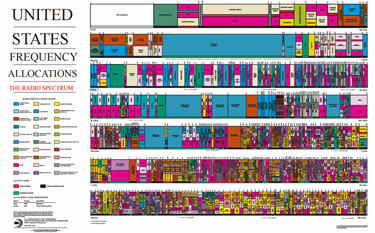$19.8 Billion Spectrum Auction Creators Explain Their AI-Driven Process
By Jof Enriquez,
Follow me on Twitter @jofenriq

A groundbreaking "incentive auction" by the US Federal Communications Commission to reallocate underutilized radio frequencies held by television broadcasters to wireless broadband providers yielded $19.8 billion in total revenue.
Government and industry have been trying to rationalize spectrum use and the latest airwave auction was meant to augment these efforts. Repurposing 84 megahertz of spectrum – 70 megahertz for licensed use and another 14 megahertz for wireless microphones and unlicensed use – was intended to shift valuable airwaves from declining broadcast viewership to ease congestion in mobile networks, to improve existing 4G LTE networks, and to lay the groundwork for 5G wireless services, which will have more capacity for bandwidth-heavy services like video streaming.
Conceived in 2012 but not completed until March 30, 2017, the Broadcast Incentive Auction produced a total of $19.8 billion in successful bids, led by T-Mobile ($8 billion) and Dish Network ($6.2 billion), according to Reuters. Comcast Corp ($1.7 billion), AT&T ($910 million) and Columbia Capital ($1 billion), rounded out the list of top winning bidders.
Broadcasters netted $10.05 billion from the auction, while the US government earned $7 billion to be deposited to the U.S. Treasury for deficit reduction, according to the FCC.
The auction itself was a complex undertaking with several interconnected factors considered, according to computer scientists and economists at the University of British Columbia and Stanford University, who designed the auction system.
As they explained in a paper in the journal PNAS: "The design challenge was not just to choose market rules to govern a fixed set of potential trades but also, to determine the broadcasters’ property rights, the goods to be exchanged, the quantities to be traded, the computational procedures, and even some of the performance objectives. An essential and unusual challenge was to make the auction simple enough for human participants while still ensuring that the computations would be tractable and capable of delivering nearly efficient outcomes."
Their solution was to implement a reverse auction solution where the price wasn't set by the highest bidders but by how low broadcasters were willing to go to turn over their airwaves, according to a press release. Further, the system also considered other factors such as the number of trades happening at once and property rights. For example, some broadcasters sold channels in different regions in the U.S. provided some local conditions were met.
"The auction paid billions of dollars to television stations to stop being broadcasters which is good for struggling stations that had no other way to sell broadcast rights," said Kevin Leyton-Brown, a UBC computer science professor. "People will be happier with faster phones and the government achieved its goal to make better use of the spectrum, which strengthens the economy and widens the tax base."
FCC since April 13, 2016 has been transitioning broadcast stations to new channel assignments to clear the airwaves for wireless carriers, which are set to improve existing coverage or build new networks.
"While we celebrate reaching the official close of the auction, there is still much work ahead of us," said FCC Chairman Ajit Pai, reported Bloomberg. "It’s now imperative that we move forward with equal zeal to ensure a successful post-auction transition, including a smooth and efficient repacking process."
